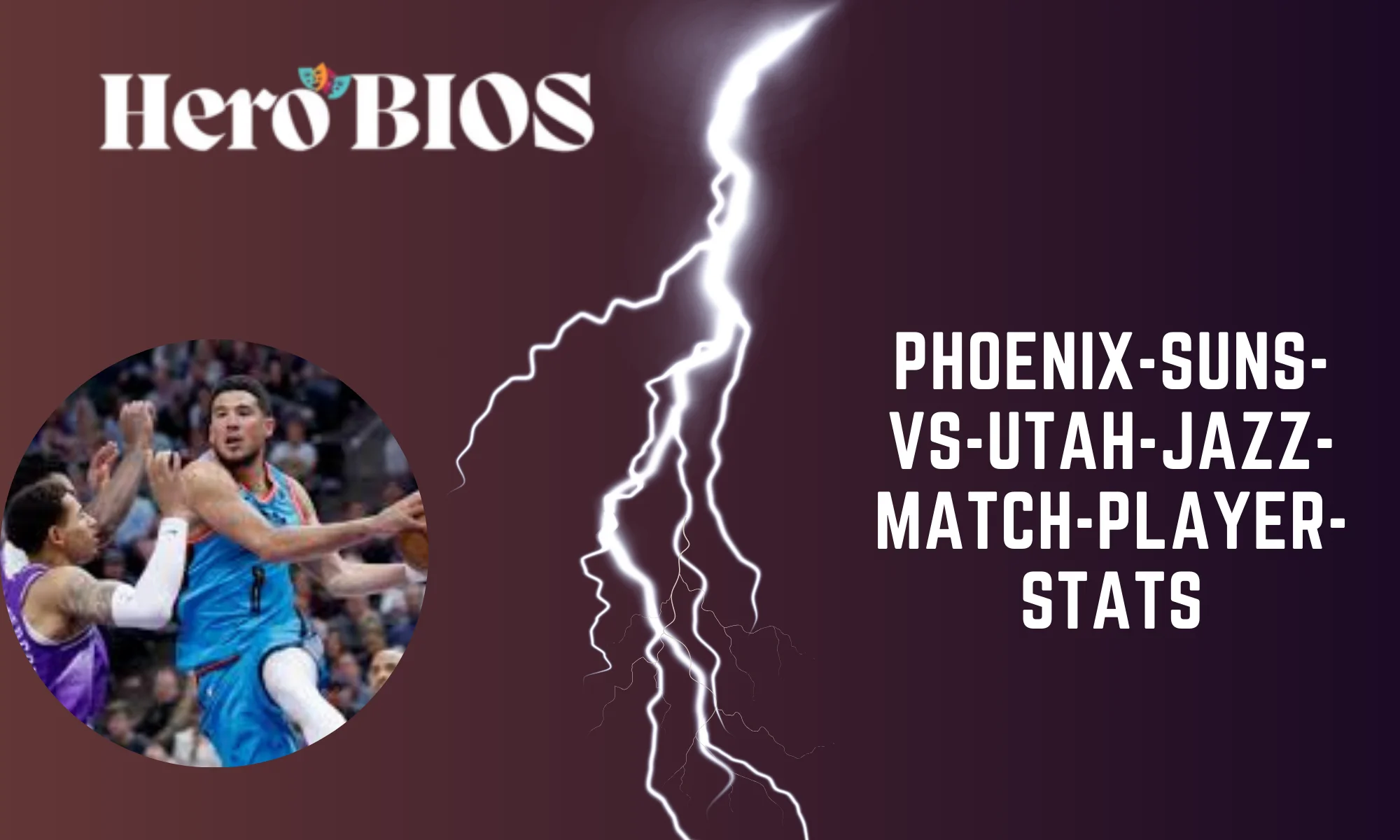When the Phoenix Suns and the Utah Jazz face off on the court, it’s always an exciting clash of offensive firepower, emerging talent, and strategic depth. These two teams, both with rich histories in the NBA, bring a mix of veteran leadership and rising stars, making their matchups a spectacle for basketball fans.
In this detailed breakdown, we will examine the Phoenix Suns vs Utah Jazz match player stats from two key games during the 2023-2024 NBA season: October 28, 2023, and February 8, 2024. We will dive deep into player performances, statistical analysis, team strategies, and what it all means for the future of these two teams.
October 28, 2023: Suns Outshine Jazz in Offensive Showcase
In the first encounter of the season, the Phoenix Suns triumphed over the Utah Jazz with a commanding 126–104 victory. The game was a high-paced offensive showcase, with both teams relying on their top players to carry them through.
Key Stats Breakdown
- Final Score: Phoenix Suns 126, Utah Jazz 104
- Top Scorers:
- Phoenix Suns: Devin Booker (27 points), Kevin Durant (24 points), Deandre Ayton (16 points, 10 rebounds)
- Utah Jazz: Lauri Markkanen (22 points), Jordan Clarkson (18 points), Walker Kessler (12 points, 8 rebounds)
Shooting Efficiency:
- Phoenix Suns:
- Field Goals: 50% (47/94)
- 3-Point Percentage: 39% (9/23)
- Free Throws: 85% (23/27)
- Utah Jazz:
- Field Goals: 45% (39/86)
- 3-Point Percentage: 33% (8/24)
- Free Throws: 80% (18/22)
Phoenix Suns’ Standout Performances

In this game, the Phoenix Suns demonstrated their balanced attack, with multiple players stepping up at various points. The team’s offense was powered by their core of Devin Booker, Kevin Durant, and Deandre Ayton.
Devin Booker’s Impact
- Points: 27
- Assists: 6
- Rebounds: 4
- Booker was the floor general for the Suns, orchestrating the offense with his playmaking ability and scoring prowess. His versatility was evident as he scored both in transition and through mid-range jumpers.
Kevin Durant’s Contribution
- Points: 24
- Rebounds: 7
- Assists: 3
- Durant’s ability to stretch the floor and score efficiently made him a constant threat. He also played a key role in spacing the floor, opening up lanes for his teammates.
Deandre Ayton’s Presence in the Paint
- Points: 16
- Rebounds: 10
- Blocks: 2
- Ayton’s size and strength were vital in controlling the paint and dominating the boards. His rim protection was also a key factor in limiting the Jazz’s inside game.
Utah Jazz’s Performance Overview

While the Utah Jazz fought hard, they struggled to keep up with the Suns’ high-powered offense. Key players like Lauri Markkanen and Jordan Clarkson led the charge for the Jazz, but their efforts were not enough to overcome the Suns’ offensive efficiency.
Lauri Markkanen’s Offensive Firepower
- Points: 22
- Rebounds: 6
- Assists: 3
- Markkanen’s ability to stretch the floor as a 3-and-D player was crucial for the Jazz. His scoring from beyond the arc and ability to finish inside kept Utah in the game, but they lacked the consistency needed to secure a win.
Jordan Clarkson’s Scoring Spark
- Points: 18
- Assists: 4
- Clarkson came off the bench and provided a much-needed scoring burst for Utah. His ability to create his own shot was evident, but like Markkanen, he struggled to find consistent support.
Walker Kessler’s Defensive Impact
- Points: 12
- Rebounds: 8
- Blocks: 3
- Kessler was a key defensive presence for Utah, anchoring their defense with his shot-blocking ability. His rim protection helped slow down the Suns, but he needed more help from his teammates.
February 8, 2024: Suns Continue to Dominate
In the second matchup of the season, the Phoenix Suns once again emerged victorious, this time with a 129–115 win. The Suns’ offense was on full display, while the Jazz struggled to contain Phoenix’s offensive weapons.
Key Stats Breakdown
- Final Score: Phoenix Suns 129, Utah Jazz 115
- Top Scorers:
- Phoenix Suns: Devin Booker (31 points), Kevin Durant (26 points), Mikal Bridges (15 points)
- Utah Jazz: Lauri Markkanen (25 points), Collin Sexton (21 points), Ochai Agbaji (13 points)
Shooting Efficiency:
- Phoenix Suns:
- Field Goals: 52% (48/92)
- 3-Point Percentage: 41% (11/27)
- Free Throws: 88% (22/25)
- Utah Jazz:
- Field Goals: 46% (39/85)
- 3-Point Percentage: 36% (10/28)
- Free Throws: 75% (18/24)
Phoenix Suns’ Contributions

The Suns showed no signs of slowing down in their second encounter with Utah. With Devin Booker leading the charge, the Suns’ offense was firing on all cylinders.
Devin Booker’s Scoring and Playmaking
- Points: 31
- Assists: 7
- Booker continued to impress, showcasing his scoring ability while facilitating the offense. His pick-and-roll game with Ayton was a focal point of the Suns’ attack.
Kevin Durant’s Leadership
- Points: 26
- Rebounds: 9
- Assists: 4
- Durant’s all-around play was crucial, as he continues to be one of the most efficient players in the NBA. His ability to score from anywhere on the floor kept the Jazz defense on their heels.
Mikal Bridges’ Defensive and Offensive Balance
- Points: 15
- Rebounds: 5
- Assists: 3
- Bridges continued to develop into a key two-way player for the Suns. His defensive tenacity was critical in slowing down the Jazz’s perimeter shooters, while his offensive contributions helped balance the attack.
Utah Jazz: A Broader Perspective
Despite the losses, the Utah Jazz showed signs of growth, especially with the development of their younger players.
Lauri Markkanen’s Consistency
- Points: 25
- Rebounds: 7
- Assists: 4
- Markkanen continued to be the Jazz’s primary scorer. His ability to stretch the floor with his 3-point shooting and score inside kept Utah competitive.
Collin Sexton’s Offensive Energy
- Points: 21
- Assists: 5
- Sexton was a major offensive weapon, utilizing his speed and driving ability to attack the basket. His scoring burst kept the Jazz in the game, but his defense left something to be desired.
Emerging Stars: Ochai Agbaji and Jaden Ivey
- Ochai Agbaji: 13 points, 2 rebounds, 3 assists
- Jaden Ivey: 8 points, 2 assists
- Agbaji and Ivey, two of the Jazz’s promising young players, showed flashes of potential. Both will need more time to develop, but their contributions could be crucial for Utah’s future.
Comparative Analysis: Suns vs Jazz

The matchups between the Phoenix Suns and the Utah Jazz offered a lot of insight into the teams’ respective strengths and weaknesses.
Offensive vs. Defensive Strategies
- Suns Offense: Phoenix relies on a perimeter-focused offense with Devin Booker and Kevin Durant as primary scorers. Their high-tempo play and ball movement make them a nightmare for opposing defenses.
- Jazz Offense: Utah has a more inside-out dynamic, with Lauri Markkanen stretching the floor and players like Jordan Clarkson and Collin Sexton attacking the rim.
Defensive Adjustments
- Suns Defense: Phoenix’s defensive schemes focused on switching defense and rim protection, with Deandre Ayton providing a solid presence in the paint.
- Jazz Defense: Utah’s defense struggled against the Suns’ offensive firepower but did show resilience in key moments. Players like Walker Kessler played important roles in protecting the rim.
Player Development and Future Outlook
Rising Stars and Emerging Talent
- Phoenix Suns: Players like Mikal Bridges and Deandre Ayton continue to develop and improve. As they mature, they will play an even more significant role in Phoenix’s championship aspirations.
- Utah Jazz: Young players such as Ochai Agbaji and Jaden Ivey are the future of the Jazz. If they continue to develop, they could provide a much-needed boost to the team’s offensive and defensive depth.
FAQs
What was the final score of the Phoenix Suns vs Utah Jazz game on October 28, 2023?
- The Phoenix Suns won 126-104.
2. Who were the top scorers for the Phoenix Suns in the October 28, 2023, game?
- Devin Booker (27 points), Kevin Durant (24 points), and Deandre Ayton (16 points, 10 rebounds).
3. Who led the Utah Jazz in scoring during the October 28, 2023, game?
- Lauri Markkanen led the Jazz with 22 points.
4. What was the Phoenix Suns’ shooting percentage in the October 28, 2023, game?
- The Suns shot 50% from the field (47/94) and 39% from three-point range (9/23).
5. How did the Utah Jazz perform in terms of three-point shooting on October 28, 2023?
- The Jazz shot 33% from beyond the arc (8/24).
6. How did the Phoenix Suns perform in the February 8, 2024, matchup against the Jazz?
- The Suns won 129-115 in an offensive showcase.
7. Who were the standout performers for the Phoenix Suns in the February 8, 2024, game?
- Devin Booker (31 points), Kevin Durant (26 points), and Mikal Bridges (15 points).
8. What was the Phoenix Suns’ shooting percentage in the February 8, 2024, game?
- The Suns shot 52% from the field (48/92) and 41% from three-point range (11/27).
9. What were the top contributions from the Utah Jazz on February 8, 2024?
- Lauri Markkanen (25 points), Collin Sexton (21 points), and Ochai Agbaji (13 points).
10. Did the Suns dominate in the paint against the Jazz?
- Yes, Deandre Ayton played a critical role in controlling the paint with 16 points and 10 rebounds in the first game and 14 rebounds in the second matchup.
11. What role did Mikal Bridges play in the Suns’ victory over the Jazz?
- Bridges provided solid defense and offensive support with 15 points, helping to balance the Suns’ attack.
12. How did Kevin Durant impact both games against the Utah Jazz?
- Durant was an all-around contributor, scoring 24 and 26 points in both games, while also grabbing rebounds and adding assists.
13. Did the Utah Jazz show any defensive improvements in the second game?
- While they struggled defensively against Phoenix’s offensive firepower, Walker Kessler provided strong rim protection, blocking several shots.
14. Who was the leading rebounder for the Phoenix Suns in both games against the Jazz?
- Deandre Ayton was the leading rebounder in both matchups, grabbing 10 rebounds on October 28 and 14 rebounds on February 8.
15. What was the performance of Jordan Clarkson in both games?
- Clarkson scored 18 points in the first game, and 15 points in the second game, providing a scoring spark for the Jazz.
16. How effective were the Phoenix Suns’ free throws in both games?
- The Suns were highly efficient, shooting 85% from the free-throw line in the first game and 88% in the second.
17. What areas did the Utah Jazz struggle in during both games?
- The Jazz struggled to contain the Suns’ high-powered offense, particularly from Devin Booker and Kevin Durant.
18. What were the key takeaways for the Phoenix Suns in their wins over the Utah Jazz?
- The Suns’ offensive efficiency, led by Booker and Durant, along with Ayton’s dominance in the paint, were key to their victories.
19. What are the Utah Jazz’s biggest strengths moving forward?
- The Jazz’s future lies in the development of their young talent, including Lauri Markkanen, Ochai Agbaji, and Jaden Ivey.
20. What does the future hold for the Phoenix Suns in the 2023-2024 season?
- The Suns look poised for a deep playoff run, with their offensive firepower and strong defensive capabilities making them a serious contender in the Western Conference.
Conclusion: Looking Ahead
As both teams look toward the future, the Phoenix Suns remain a dominant force in the Western Conference with their powerful offensive schemes and defensive improvements. Devin Booker and Kevin Durant lead the way, with a strong supporting cast. The Utah Jazz, on the other hand, are in a rebuilding phase, focusing on the development of emerging talent like Ochai Agbaji and Jaden Ivey.
With the upcoming matchups and roster changes, the Suns are likely to maintain their dominance over the Jazz. However, Utah’s potential for growth means that future encounters may become more competitive, especially if their younger players continue to rise.
As we move further into the 2023-2024 NBA season, the questions raised about team depth, player development, and future matchups will continue to shape the narrative for both teams. The Suns’ offensive juggernaut will test the Jazz’s defensive strategies, making for an exciting continuation of this rivalry in the coming seasons.










